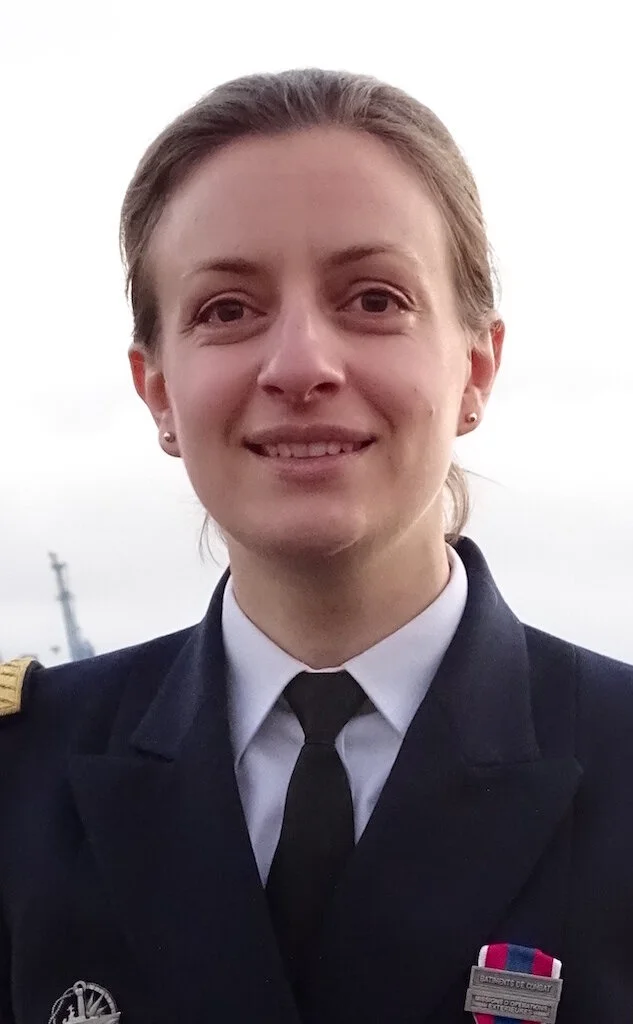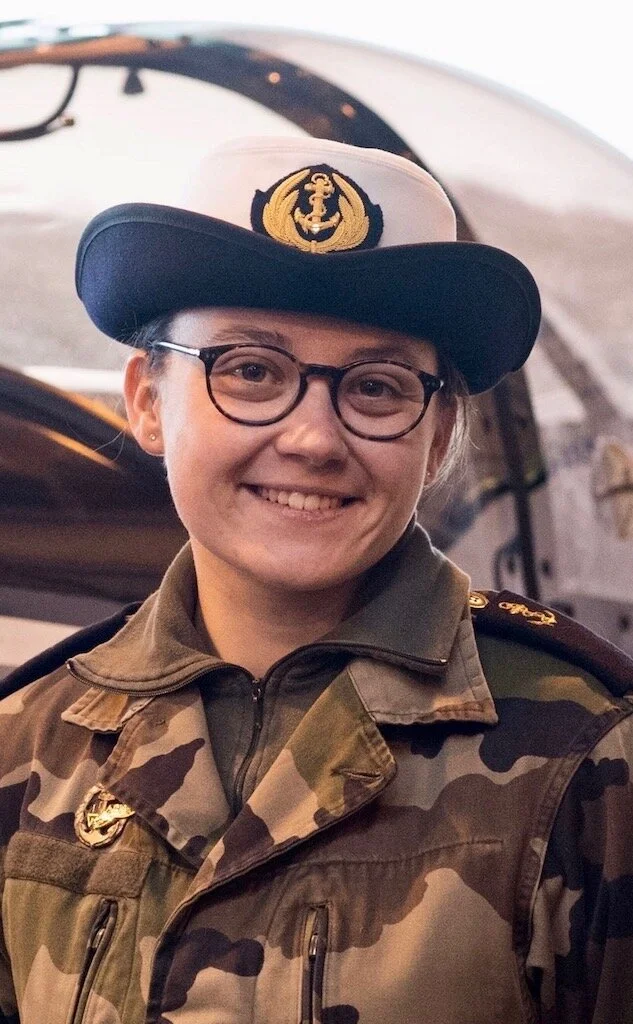Chief Petty Officer Hélène
Chief Petty Officer Hélène. Photo credit: French Navy
It was the lapel pin with two dolphins on it worn by some of her crew-mates aboard her first ship that alerted Hélène to a job she'd never heard of: navy diver. A few years after first spotting them she became the first woman to successfully complete the French Navy's gruelling bomb disposal diver course and is currently one of only three female bomb disposal divers in the force.
But, contrary to what one might expect, this slightly reserved, soft-spoken, mother-of-three, does not look like a female Rambo! She's 1m72 tall and weighed 64kg when she started training (now down to 58kg “and a lot more muscle in my legs thanks to running and in my back and arms because of carrying heavy loads” she laughs). In fact, she admits, that as a youngster she “was a really poor swimmer!”
“ “I’d no idea the navy recruited at all levels and for so many different types of jobs””
Her father's job as a plumber at the defence ministry in Paris was her only link with the armed forces. Her Polish mother was a translator and Hélène and her four younger sisters would spend family holidays on the Ile de Ré off France's Atlantic coast which was her annual rendezvous with the sea. “I was quite good at school but was drawn to jobs that would allow me to use my hands rather than being stuck behind a desk,” she says.
Realising that her literary studies were likely to lead to a desk job and desperate to find something else, she searched for answers in a booklet: “What to do with or without the bac.” The navy was mentioned. “Like many, I thought the navy was reserved for scientific minds prepared to do a lot of maths for the competitive exams to get into the Naval School and become naval officers. I'd no idea the navy recruited at all levels and for so many different types of jobs,” she explains. “Also,” she smiles, “I thought the uniform was cool, I liked the discipline, the travel and being on a boat.” She laughs when she remembers telling her mother “as a joke,” that “I'd decided to join the navy.” But, what had started out as a joke slowly took form “and the more I studied the option, the more I liked it.”
She got her baccalaureate in 2000 and in parallel submitted an application to the navy. “With my literary bac my choice of navy careers was pretty limited. So I applied to do transmissions and communications.” She was turned down the first year but, undaunted, re-applied in 2001 and got in.
After completing her training she got a job on the Georges Leygues, an anti-submarine frigate, “and that's where I saw this dolphin lapel-pin on some of my colleagues. As there were only about 180 of us on board, I had plenty of opportunity to watch them working.” She observed for a year and “then with another girl and a guy from the ship we decided we wanted that dolphin badge too so we bought some snorkelling gear from the local sports shop and trained every day after work for a year.” This personal training, she says, is what enabled her to successfully complete the five-week training course at the armed forces divers' training facility in Saint Mandrier on the Mediterranean, where she was the only woman. “This is one of the most interesting training courses in the navy,” she remarks, “but it has a reputation of being highly selective which is why I think other women are put off applying.” But she was determined and got in on her third application. Hélène describes the course as being “physically very dense” with a lot of running “and where candidates are really made to feel that they must prove themselves.”
Of the 30 candidates who started, only 20 finished “either because they failed one of the requirements or chose to drop out.”
With her dolphin badge proudly pinned to her uniform, Hélène returned to sea where she, like all other divers, worked at her initial job in addition to diving. “I'd really enjoyed the training course and realised that diving was what I wanted to do full-time. My job as a transmitter at sea was coming to an end and I really didn't fancy finding myself in an office,” she smiles. So after thinking about it for a semester she applied for the nine-month bomb disposal diver course “which generally only admits the best of the earlier diving course,” she explains... so modestly that she appears to be talking about somebody else altogether! She was the only woman on the course so roomed with other women working at the diving school. “But I shared the guys’ changing room,” she shrugs “because there was no time to go anyplace else as we always had to change really fast.”
Hélène practicing her bomb disposal skills on a fake bomb during a training exercise in 2012. Photo credit: French Navy
Hélène explains that naval divers plunge to a depth of 35m whereas the bomb disposal divers go more than twice as deep, to 80m. “The maths is very applied and perfectly understandable by anyone,” she says dismissing the difficulties of calculating volume, density and mass when faced with an explosive device to dismantle at that depth. “Disposing of a bomb underwater is very different than on land,” she explains. “Rather than putting more protective gear on, we take as much off as possible so as not to create any magnetic field, for example, that could set the thing off.” The breathing apparatus they use is made of plastic and steel so has no magnetic signature at all.
For each of her three children she stopped diving as soon as she realised she was pregnant. “That's the rule because nobody wants to be the guinea-pig to see how deep diving can affect an embryo,” she remarks.
Today, whenever her children (aged 18 months to 9 years old) give her a break, she enjoys doing a bit of DIY at home or sitting at her sewing machine making clothes for them. “I also love singing in the church choir and helping out with mass,” she says. But she concedes that the “navy doesn't do you any favours when you've chosen a man's job” and that it is sometimes hard with an operational job like hers to reconcile one's professional aspirations with one's personal life. Which is why she counsels that to do a job like hers you need “unswerving will-power, particularly over the long term.”





